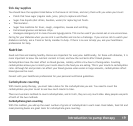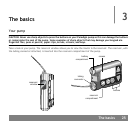
glucose, test your blood glucose 2 hours after you eat. Keep records of foods that you eat on regular basis. Note
the bolus amounts and post-prandial readings for each entry. If your reading is too high or too low, adjust your meal
bolus the next time you make that food choice.
Exercise
Your body needs insulin and carbohydrate to provide cells with energy during exercise. How much insulin and
carbohydrates you need varies with the types of exercise and with how often you exercise. Using an insulin pump
during exercise allows you to reduce your basal rate instead of eating extra carbohydrate. Before, you needed to
eat extra carbohydrate to make up for the glucose lowering effect exercise often has on blood glucose. It takes
trial and error to get the balance right.
The body needs insulin during exercise. Therefore, it is not suggested that you stop the pump unless the exercise
is for a short amount of time (1 hour or less). If you need to remove the pump for more than 1 hour, refer to the
If you remove your pump section in the The basics chapter.
If you do an exercise that on average lowers your blood glucose, you can use the temporary basal rate feature. You
can use this feature to lower the amount of insulin delivered and reduce the risk of hypoglycemia. You may also
choose to change your basal rate pattern for the days you exercise.
It takes a period of time to determine how much to adjust your basal rate during exercise. Record your blood glucose
before, during and after exercise to figure the proper reduction in your basal rate. Record any carbohydrates that
you have eaten during the exercise period. There is no magic formula that will tell you just what to do. You have
to test often to figure out the basal rate that you need during exercise.
Introduction to pump therapy 23


















